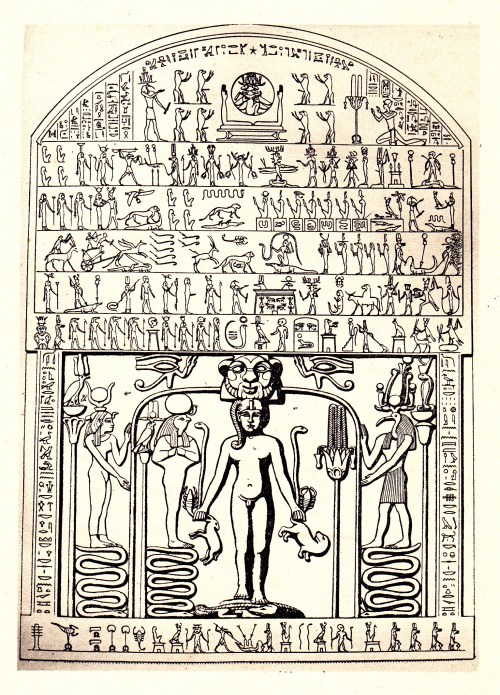Gnostic Magical Names From the Metternich Stele and the Harris Magical Papyrus
“The examples of the use of names possessing magical powers described above illustrate the semi-religious views on the subject of names which the Egyptians held, and we have now to consider briefly the manner in which the knowledge of a name was employed in uses less important than those which had for their object the attainment of life and happiness in the world to come.
In the famous magical papyrus (British Museum, No. 10,042) which Chabas published (Le Papyrus Magique Harris, Chalon-sur-Saône, 1860) we find a series of interesting charms and magical formulæ which were written to preserve its possessor from the attacks of sea and river monsters of every kind, of which the following is an example.
“Hail, lord of the gods! Drive away from me the lions of the country of Meru (Meroë?), and the crocodiles which come forth from the river, and the bite of all poisonous reptiles which crawl forth from their holes. Get thee back, O crocodile Mâk, thou son of Set! Move not by means of thy tail! Work not thy legs and feet! Open not thy mouth! Let the water which is before thee turn into a consuming fire, O thou whom the thirty-seven gods did make, and whom the serpent of Râ did put in chains, O thou who wast fettered with links of iron before the boat of Râ! Get thee back, O crocodile Mâk, thou son of Set!”
These words were to be said over a figure of the god Amen painted on clay; the rod was to have four rams’ heads upon one neck, under his feet was to be a figure of the crocodile Mâk, and to the right and left of him were to be the dog headed apes, i.e., the transformed spirits of the dawn, who sang hymns of praise to Râ when he rose daily. (See the scene in the rounded portion of the Metternichstele illustrated on p. 149, reproduced below).

Detail, Metternich stele. (Clippus of Horus, Metternichestele, ed. Golenischeff, plate 1.)
Reproduced from E.A. Wallis Budge, Egyptian Magic, p. 149.
Again, let us suppose that some water monster wished to attack a man in a boat. To avoid this the man stood before the cabin of the boat and, taking a hard egg in his hand, he said, “O egg of the water which hath been spread over the earth, essence of the divine apes, the great one in the heaven above and in the earth beneath, who dost dwell in the nests which are in the waters, I have come forth with thee from the water, I have been with thee in thy nest, I am Amsu of Coptos, I am Amsu, lord of Kebu.”
When he had said these words he would appear to the animal in the water in the form of the god Amsu, with whom he had identified himself, and it would be afraid and flee.
At the end of the papyrus in which the above extracts occur we find a series of magical names which may be read thus:–Atir-Atisa, Atirkaha-Atisa, Samumatnatmu-Atisa, Samuanemui-Atisa, Samutekaari-Atisa, Samutekabaiu-Atisa, Samutchakaretcha-Atisa, Tâuuarehasa, Qina, Hama, Senentuta-Batetsataiu, Anrehakatha-sataiu, Haubailra-Haari.
From these and similar magical names it is quite certain that the Gnostics and other sects which held views akin to theirs obtained the names which they were so fond of inscribing upon their amulets and upon the so-called magical papyri.”
E.A. Wallis Budge, Egyptian Magic, London, 1901. P. 173-6.
